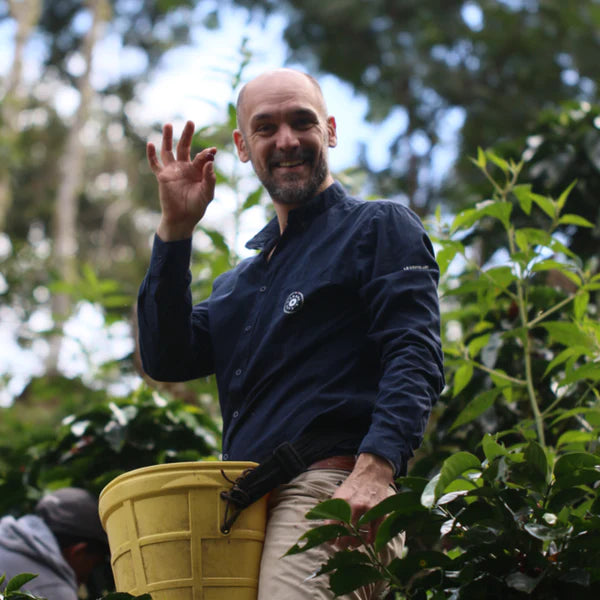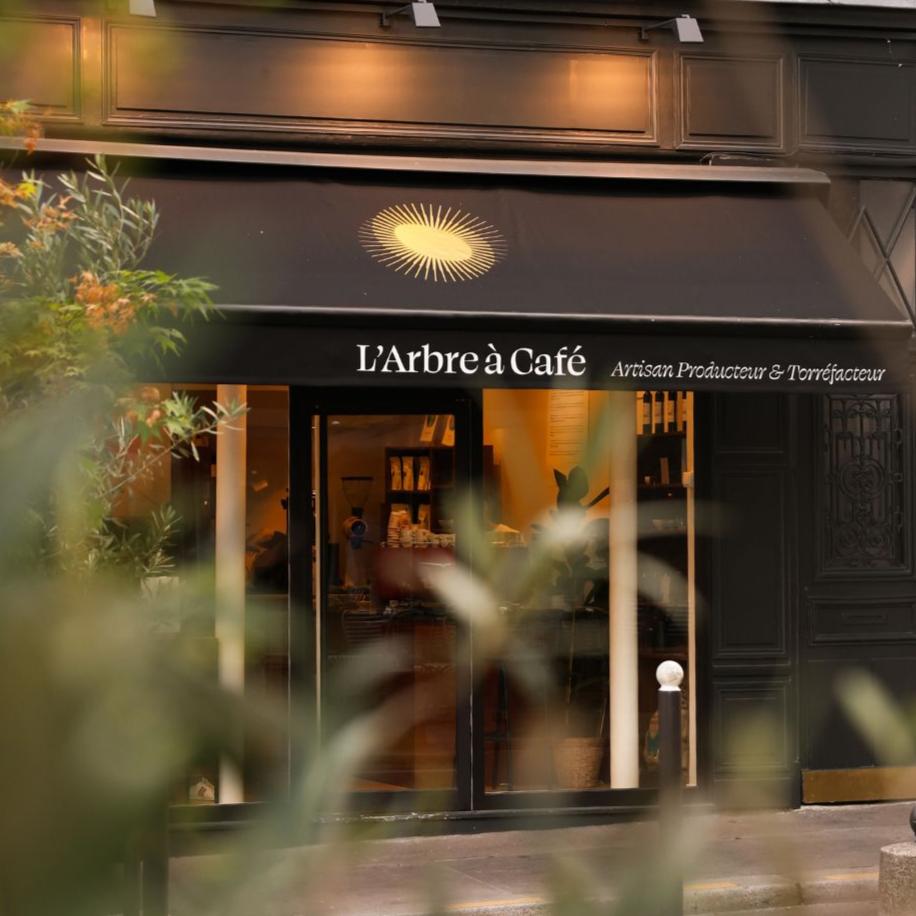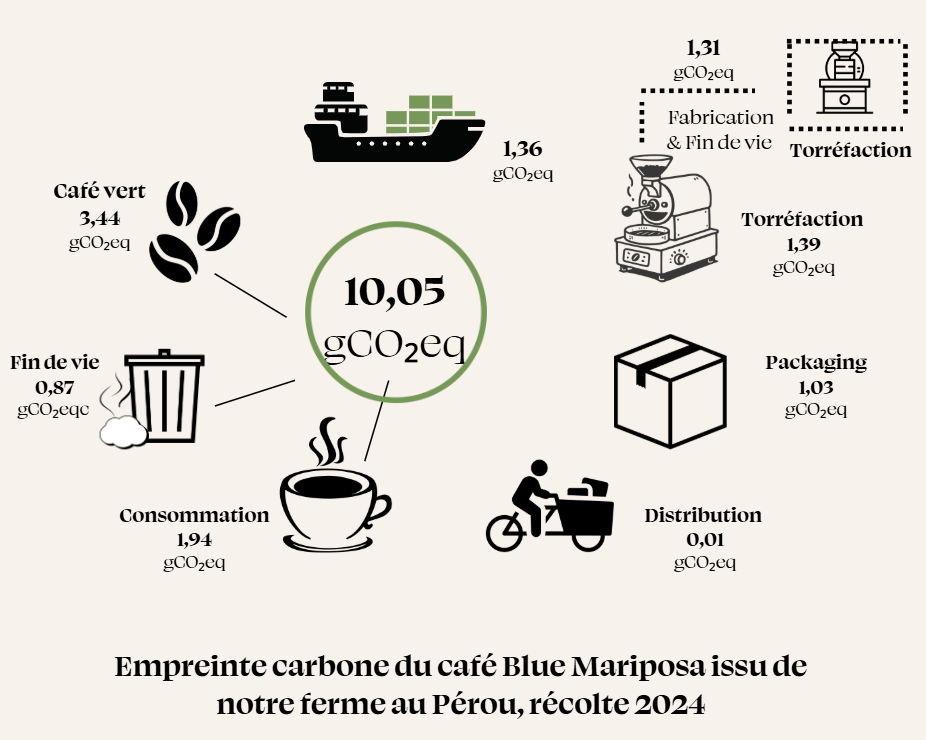Since 2009, L'Arbre à Café has been working to transmit and disseminate high quality coffee. Through its close and direct collaboration with coffee producers, chefs and artisans, through the selection of rare biodynamic vintages, through state-of-the-art artisanal roasting, and through service and innovation, L'Arbre à Café is committed daily to founding a new French art of coffee. Its values of excellence, short circuit, biodynamics and innovation, make the realization of the 101 words of coffee sound like an obvious choice.
The 101 words of coffee, for everyone's use, brings together all the diversity of the actors in the world of coffee, from producers to amateurs, including roasters and taste experts. Everyone works in this caffeinated world, often in such an essential way.
More than 90 contributors tell you about their favorite field, their own coffee, and give you their views on this cup so mysterious, tasty and complex that some read the future in it.
They are coffee professionals, whether it be in its cultivation (producer), fermentation, roasting, or service (barista), they are sometimes even world champions in their discipline, and star producers. Others evolve in fields that are not directly related to coffee, but sometimes integrate it, such as cooking with Anne-Sophie Pic, Yves Camdebordeou Guy SavoyOthers are involved in fields that are not directly related to coffee, such as cooking with Anne-Sophie Pic, Yves Camdeborde, medicine with Henri and Jean Joyeux, sommellerie, and room service with Denis Courtiade, but also less directly, such as music, theater, or perfume with the magazine Nez.
They come from France and Navarre, but especially from this global village strongly invigorated and animated by coffee, that of Speciality, mainly. All of them have a useful and enlightening look, often sensitive, on coffee.
The official release date is December 15, the perfect gift for all coffee and food lovers!
With a few days to go before its release, we are unveiling some excerpts of the words associated with the world of coffee. Each week, new excerpts will be posted on our Facebook page:
Kawa, coffee, caffè, so many words that inhabit our imagination and our daily lives, fill our lives and our homes with aromas and memories. Faithful friend of the key moments of life "Come on, let's go for a coffee", symbol of an urban art of living, that of the cafes, literary, theater or of counter and small black, the coffee is a unique companion of our existences, a universal and intimate drink. More than 2 billion cups are drunk every day in the world, and yet, we know very little about this nectar, which comes from Ethiopia and Africa, and which is in the process of acquiring its letters of nobility and of being elevated to the pantheon of gastronomic products.
Preface by Anne-Sophie Pic - Starred chef ***
AMORE
[...] The love of a whole system which, if it were not based on love... would be nothing but boredom.
Franceso Illy,Illy Caffè, Amici caffè and wine producer in Montalcino, Podere Le Ripi. www.podereleripi.com
---
BIODIVERSITÉ
What is the biodiversity related to the 8.5 million tons of coffee produced in 2015 or the 2.2 billion cups of coffee consumed every day in the world? The perception of this biodiversity depends on the actors involved (producers, industry, consumers) and the scientists consulted (biologists, agronomists, ecologists).
[...]Coffee growers essentially cultivate two species of coffee trees - Coffea arabica for Arabica coffee or C. canephora for Robusta. [...] The standard Arabica varieties grown for the coffee industry are the Typica and Bourbon origins of Arabica from Yemen, which have been disseminated worldwide (17th-19th centuries), and varieties derived from them such as Mundo Novo, Caturra, Catuai in Latin America. Other traditional varieties grown locally also enjoy a good reputation: Maragogipe in Mexico, Geisha in Panama, Blue Mountain in Jamaica, Kona in Hawaii, SL28 in Kenya, Kent in India...
André Charrier, Professor-researcher in Genetics (retired), ASIC, Ird & CIRAD. Deputy scientific secretary, Association for Science and Information on Coffee (ASIC). Research on coffee diversity and genetic improvement (Ird & Cirad).
---
[...] The beans, like the fruit, are small and oblong and therefore require careful roasting to avoid burning the end. However, it is its organoleptic excellence that seduces the palate. It is characterized by a great balance and an extreme complexity.
Its full body, its very wide aromatic palette from red to yellow fruits with woody and honeyed notes. But also lychee, tangerine or violet are among the aromas commonly perceived. What impresses the consumer the most is the length in the mouth of the nectar, which seems to never fade and which, from our experience,
has no equivalent. Laurina is not known for its extreme aromatic intensity like Geisha or Rume Sudan or SL 28, or even for its strength like the coffees of Java, but for its delicacy, complexity and persistence that gives the consumer a long sensation of balanced well-being [...].
Frédéric Descroixfather of the Bourbon Pointu
---
COFFEE COLOR
[...] Couleur café has an irresistible palette. Two native words that mate prodigiously and bring grist to the mill... When reading these two words, it is impossible to resist their sensuality, undulating lasciviously from one side to the other, Serge could have sung it. [...]
FEGU, Thinker in food.
---
CRACK
[...] Cracking occurs when the cell walls are most fragile. The location on the grain where the crack occurs can also be
crack occurs can also be identified by a skilled roaster. A lot of energy is released during this brief moment. The bean becomes endothermic again and resumes a cycle of increasing internal pressure until the 2nd crack. [...]
Veda Viraswami
---
E61
Around the Barista, there are many beautiful stories that tell the life and evolution of coffee, those of the producers and those of the Finca. One of these stories begins in Milan at FAEMA (Fabricca Apparecchiature Elettromeccaniche e Affini), a famous brand of espresso machines, which in 1961 launched a new espresso machine that has since become iconic. It was named E61 in homage to the total solar eclipse of February 15, 1961 at 8:35 am (E=eclipse and 61 for the year 1961). The ambition of the machine was thus clear, to eclipse the manual steam machines then in force. This machine, created by Carlo Ernesto Valente, definitively changed the way of extracting coffee. [...]
.
Luca CasadeiBarista, double champion of France.
---
GEISHA
[...] Geisha is a singular variety. It requires a terroir that is perfectly attuned to its delicate sensitivities, its weak root system and its particular foliage. [...]At Finca Deborah, we plant 2,200 Geisha trees per hectare, less than half of what is done with most traditional varieties. Each tree must take up its full space, so there must be a large distance between each trunk. [...]The extreme altitude of Finca Deborah ranges from 1,900 to 2,000 meters above sea level, which reduces productivity by up to 50% and pushes the date of the first harvest from the third to the fifth year of life after planting. And these are just a few of the risks and demands that Geisha places on its grower. [...]And while the market continues in its struggle to stabilize prices, growers persevere in their efforts to refine and expand their knowledge of this enigmatic variety, constantly improving production and processes.
Jamison SavageProducer of biodynamic coffee from the Deborah finca
Read the article about the work of Jamison Savage of Finca Deborah
---
GUERIDON
"Would you like a hot drink to finish your meal?" This is the commonplace question asked of post-dessert customers. The same question that leads to the conclusion of a meal. The overall experience of the meal, which includes the kitchen, the reception and the service, must undeniably end on a high note. Without false note. [...]The only way to make coffee even better is to serve it at a pedestal table. The idea: spend time, argue and make the coffee chosen by and for the guests. This is not invasive, on the contrary, the time wants the latter to be more informed, and in demand of specialized information. At a time when traceability is on everyone's lips, this precious time allows us to talk about the origin and history of the beverage [...].
Hélène Binetjournalist, Un Oeil en Salle.
---
JACU
What is it? Simply a bird, like a small grey pheasant with less elegance. One of its peculiarities is that it loves coffee beans when they are ripe and therefore irritates the producers, because its greed is limitless. The exasperation of one of them, who had chosen biodynamic agriculture for some years, in Brazil, was pushed to the point of having a surprising idea at first, but finally brilliant. Let's recover," he told his employees, "the coffee beans in the droppings of the Jacu! [...] With this harvest, carefully cleaned, the idea was to test the taste blind, and to everyone's surprise, it was a gustatory triumph to the point of winning unanimous approval from the most demanding juries!
Nicolas Joly, Winemaker at the Coulée de Serrant, Savennières, and author of books on Biodynamics.
---
INFINITELY COFFEE MACAROON
[...] I really like the coffee macaroon. You have to have tasted it one day.[...] The discovery with Hippolyte Courty of Grands Crus like the Red Iapar from Brazil or the Bourbon Pointu from Reunion Island changed everything. My macaroon of yesterday is now both the same and completely different. More than a sensation, it now has an infinitely coffee taste.
Pierre Hermé, Pastry chef
---
MOKANIS
[...] In some regions of Spain, it is customary to add a drop of aniseed to coffee. Two flavors that, mixed together, create a new and unique perfume. [...].
Yann Couvreurpastry chef
---
PERFUM
[...] Perfume is the sense of smell, the sense of smell is the memory, a memory with a powerful evocation power. There are hundreds of coffee fragrances. Let me mention 4 that touch me, and I know that everyone can add their own.
Coffee scent, childhood scent. The smell that touches us the most is of course the coffee that exhales in the morning from a coffee pot. This warm and powerful smell is carried throughout the house and, penetrating our sleepy nostrils, summons a chain of memories, pleasures, stimuli, and awakenings. This coffee is my own madeleine, my childhood, my home, the scent of happiness. [...]
---
SHARE
[...] In the age of the Internet and the virtual world, coffee is and will always remain the drink of real connection between individuals, the drink of exchange and sharing par excellence.
Guillaume ZighmiChief Operating Officer of L'Arbre à Café
---
TASTE
[...] The cup, like any matrix, is there to collect, welcome, make bloom and express, to be finally deserted and abandoned. If theologists and oenophiles benefit from a plethora of glassware and tableware adapted to each type of nectar and each moment of tasting, coffee lovers know this happiness only in a very partial and new way. [...]It is in this context, that we created, Sylvie Amar, the Montgolfier establishments and myself, the Revelation® cup. This one answers our idea of the coffee tasting. Without handle, in sandstone, its contact is round, warm and soft. It thus prepares for a greedy, peaceful and open tasting. [...]
Sylvie AmarGlobal designer specialized in gastronomy, Sylvie Amar Studio www.sylvieamarstudio.com
---
TIME
Coffee time is a very serene moment in Japan. From the brewing to the tasting, it is a detached moment, like the time of a tea ceremony. And we think that like tea, a good coffee requires a precise and flawless gesture. The ideal place is at the counter, behind which the "master" prepares his concoction for us and we come to appreciate this atmosphere with our five senses. [...]
Aya Ito, Japanese food journalist, based in Paris. She writes for many Japanese newspapers. President of the French-Japanese gastronomic media DOMA
---
TORRÉFACTOR, THE MACHINE
[...]For reasons of economy and optimization, the large food groups resort to fluidization roasting, where very hot air is blown into a cone in which the beans float in suspension. The air temperature is then close to 800°C, which drastically reduces the roasting time to less than ten minutes for very large volumes of coffee. Industrialists also use flash roasting. Artisanal roasting is generally gentler and longer (up to 20 minutes), but it guarantees quality and meticulous work to reveal all the aromas thanks to the progressive and variable cooking according to the terroir of each coffee.
Co-founder PIHA. Agent France Probat® Shop-Roaster.
---
TORREFACTION
In the beginning were the coffee bean and the roaster. And the bean was in his hands. The bean needed the roaster and the roaster needed the bean. He saw that the bean was good and said to it: "Let me roast you, I will make you a new bean, the one you must become, the one I feel you can become [...]
Gregory Sarafian, Roaster of L'Arbre à Café
---
WINE
The world of coffee, like that of wine, is very complex and is made up of hundreds of molecules that allow us to identify the varieties of coffee trees or grape varieties used, the types of plantation and the production techniques, among others. The two areas have many points in common, especially their very diverse aromatic palettes that reflect the infinite variations of their respective elaborations, because wine and coffee are both fermented products. The hundred or so coffee trees, the thousands of grape varieties, the wide range of terroirs which are counted by the hundreds and the climates are not for nothing in this multitude of aromatic components. [...]
Bernard Burtschy, PhD in Mathematical Statistics and Professor at Télécom ParisTech.
---
TRAVEL
When asked what kind of coffee I serve at the regalade, I have long liked to answer: French coffee! It is certainly not in the Beauce region or among the vineyards and chilli plantations of the Pyrenean foothills that coffee is grown in France. But Reunion and Guadeloupe are two departments of our country where coffee trees are found between vanilla and banana trees in family farms of tropical plants. Thanks to Jean-Paul Logereau, one of the most famous Parisian coffee roasters, who used to run the Brûlerie des Gobelins, at the bottom of the rue Mouffetard, I discovered the Bourbon Pointu from Reunion and Bonifieur from Guadeloupe, considered as one of the best coffees in the world by coffee lovers. Jean-Paul Logereau having sold his store and retired, I now buy my coffee at L'Arbre à Café, the house that Hippolyte Courty oversees, on rue du Nil, near the Grands Boulevards. Hippolyte selects for me coffee from India, Ethiopia, Brazil and Panama. Coffee continues to make me see the country. That's why when someone says to me: coffee, I answer: travel. [...]
Yves Camdeborde, Chef and owner of the Relais Saint Germain, and the Avant-Comptoirs (Terre, Mer et Marché), Saint-Germain, Paris. A world-renowned chef and unwitting inventor of Bistronomy.




















